Circulatie Study guides, Class notes & Summaries
Looking for the best study guides, study notes and summaries about Circulatie? On this page you'll find 39 study documents about Circulatie.
Page 2 out of 39 results
Sort by
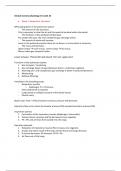 Popular
Popular
-
Clinical Exercise Physiology tm week 10
- Summary • 63 pages • 2023
-
- $6.63
- 3x sold
- + learn more
This summary describes the main lines of the Clinical Exercise Physiology course. The summary is divided into the different weeks that the subject has. For example, the following components are covered: respiration, circulation, the influence of exercise on the body, the building of muscles with the influence that exercise has on this and much more. Written in a simple way, in short, the ideal preparation for the first exam of the course!
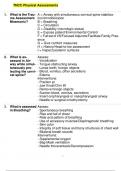
-
TNCC Physical Assessments 1. What is the Trauma Assessment Mnemonic?: A = Airway with simultaneous cervical spine stabilization/immobilization B = Breathing C = Circulation D = Disability (neurologic status) E = Expose patient/Environmental Control F = Fu
- Exam (elaborations) • 7 pages • 2023
-
- $9.49
- + learn more
TNCC Physical Assessments 1. What is the Trauma Assessment Mnemonic?: A = Airway with simultaneous cervical spine stabilization/immobilization B = Breathing C = Circulation D = Disability (neurologic status) E = Expose patient/Environmental Control F = Full set of VS/Focused Adjuncts/Facilitate Family Presence G = Give comfort measures H = History/Head-to-toe assessment I = Inspect posterior surfaces
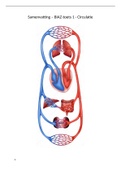
-
BAZ/BIAZ Circulation
- Summary • 95 pages • 2021
- Available in package deal
-
- $9.95
- 11x sold
- + learn more
This summary was made in preparation for the BIAZ (Basic Introduction Acute Care). The summary is based on the Circulation theme one of the three parts of the BIAZ. The summary was made using theory from the books Anatomy and Physiology, an introduction and ProActive Nursing: clinical issues in sight.
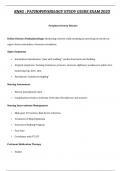
-
Define Disease/Pathophysiology: thickening of artery walls resulting in narrowing of arteries in upper/lower extremities; decreases circulation
- Exam (elaborations) • 28 pages • 2023
-
- $17.99
- + learn more
Define Disease/Pathophysiology: thickening of artery walls resulting in narrowing of arteries in upper/lower extremities; decreases circulation
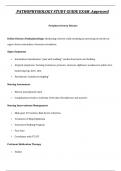
-
Define Disease/Pathophysiology: thickening of artery walls resulting in narrowing of arteries in upper/lower extremities; decreases circulation Signs/Symptoms • Intermittent claudication-“pain with walking”-results from lactic acid buildup • Atypical symp
- Exam (elaborations) • 28 pages • 2023
-
- $17.99
- + learn more
Define Disease/Pathophysiology: thickening of artery walls resulting in narrowing of arteries in upper/lower extremities; decreases circulation Signs/Symptoms • Intermittent claudication-“pain with walking”-results from lactic acid buildup • Atypical symptoms- burning, heaviness, pressure, soreness, tightness, weakness in ankle, foot, hamstring, hip, knee, shin • Paresthesia “numbness/tingling” Nursing Assessment: • History and physical exam • Complications-leads to isch...
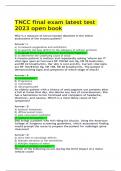
-
TNCC Physical Assessments 2022 What is the Trauma Assessment Mnemonic? A = Airway with simultaneous cervical spine stabilization/immobilization B = Breathing C = Circulation D = Disability (neurologic status) E = Expose patient/Environmental Contro
- Exam (elaborations) • 12 pages • 2024
-
- $10.99
- + learn more
TNCC Physical Assessments 2022 What is the Trauma Assessment Mnemonic? A = Airway with simultaneous cervical spine stabilization/immobilization B = Breathing C = Circulation D = Disability (neurologic status) E = Expose patient/Environmental Control F = Full set of VS/Focused Adjuncts/Facilitate Family Presence G = Give comfort measures H = History/Headtotoe assessment I = Inspect posterior surfaces What is assessed in Airway while simultaneously protecting the cervical sp...
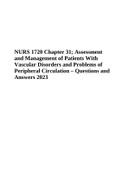
-
NURS 1720 Chapter 31; Assessment and Management of Patients With Vascular Disorders and Problems of Peripheral Circulation – Questions and Answers 2023
- Exam (elaborations) • 26 pages • 2023
-
- $14.49
- + learn more
NURS 1720 Chapter 31; Assessment and Management of Patients With Vascular Disorders and Problems of Peripheral Circulation – Questions and Answers 2023. The nursing instructor is talking with the nursing students about peripheral arterial occlusive disease (PACD). The instructor points out that when assessing a patient for PACD the nurse would expect to find what? A) Equal pulses in the extremities B) Unequal pulses between extremities C) Equal skin color between extremities D) Warm feet...
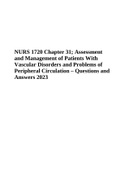
-
NURS 1720 Chapter 31; Assessment and Management of Patients With Vascular Disorders and Problems of Peripheral Circulation – Questions and Answers 2023
- Exam (elaborations) • 26 pages • 2023
-
- $13.99
- + learn more
NURS 1720 Chapter 31; Assessment and Management of Patients With Vascular Disorders and Problems of Peripheral Circulation – Questions and Answers 2023. The nurse is taking a health history on a new patient. The patient reports experiencing pain in the left lower leg and foot when walking. This pain is relieved with rest. The nurse notes that the left lower leg is slightly edematous and is hairless. What does the nurse suspects that the patient may be experiencing? A) Coronary artery disea...
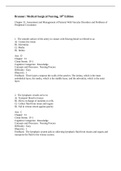
-
Brunner: Medical-Surgical Nursing, 10th Edition Chapter 31: Assessment and Management of Patients With Vascular Disorders and Problems of Peripheral Circulation
- Exam (elaborations) • 14 pages • 2022
-
- $12.49
- + learn more
Brunner: Medical-Surgical Nursing, 10th Edition Chapter 31: Assessment and Management of Patients With Vascular Disorders and Problems of Peripheral Circulation 1. The smooth surface of the artery in contact with flowing blood is referred to as: A) Connective tissue B) Adventitia C) Media D) Intima Ans: D Chapter: 31 Client Needs: IV-1 Cognitive Categories: Knowledge Concepts and Processes: Nursing Process Difficulty: Easy Objective: 1 Feedback: Three layers compose the walls of t...

-
A 43-year-old African American male is admitted with sickle cell anemia. The nurse plans to assess circulation in the lower extremities every 2 hours. Which of the following outcome criteria would the nurse use?
- Exam (elaborations) • 1 pages • 2022
-
- $22.99
- + learn more
A 43-year-old African American male is admitted with sickle cell anemia. The nurse plans to assess circulation in the lower extremities every 2 hours. Which of the following outcome criteria would the nurse use?

How much did you already spend on Stuvia? Imagine there are plenty more of you out there paying for study notes, but this time YOU are the seller. Ka-ching! Discover all about earning on Stuvia


